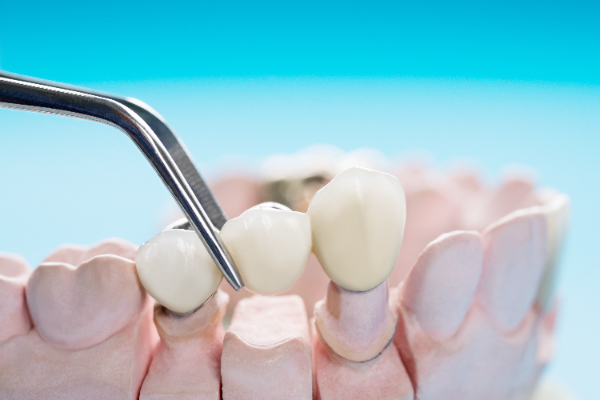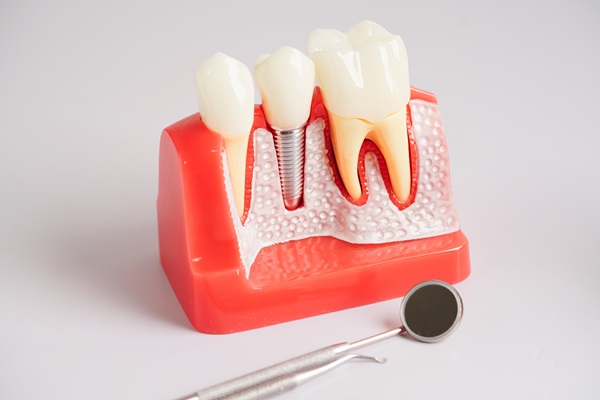Dental Bridges Can Replace Missing Teeth

If an individual is missing a few teeth, dental bridges can help. Missing teeth can be due to a variety of reasons. Bridges are fixed prosthetics that can help solve the gap of missing teeth. They are an excellent option for individuals who may not need a complete set of dentures, as they are only missing a few teeth.
Why get a dental bridge to aid with missing teeth?
Individuals who have lost several teeth may choose a dental bridge, which comes with several benefits. Not only does the dental bridge help replace the missing teeth, but it also helps fill in the individual’s smile. These prosthetics allow the individual to resume normal eating, drinking, and speaking, which may have previously been impaired by tooth loss. They can also help relieve pressure and wear on your remaining teeth by dispersing bite force appropriately.
How many missing teeth can a dental bridge accommodate?
The number of missing teeth bridges can replace varies depending on the surrounding healthy teeth. Since bridges use surrounding teeth for attachment points for the prosthetic tooth, the teeth around the impacted area must support the bridge. Depending on the supporting teeth, bridges may replace just one tooth, possibly even four or more teeth.
How does it work?
Dental bridges close the gap left by missing teeth using two or more crowns attached to abutment teeth on either end of the space. Abutment teeth are essentially the adjacent teeth that will support the bridge. The prosthetic teeth, called pontics, are constructed on a metal base and covered with porcelain. The artificial teeth will be shaded to match the nature of the natural teeth, ensuring the individual’s smile appears seamless.
What to expect during the procedure
Individuals who are interested in being fitted for a bridge should speak with their dentist. The procedure starts with X-rays and an examination to determine if the surrounding teeth are strong enough to support the dental bridge. Dentists will also check for any underlying issues, such as teeth decay or infections, which will be treated before receiving the treatment.
The abutment teeth will be prepared for the placement of dental crowns, and this is done by shaving off a portion of the enamel. Measurements will be taken, as well as a mold of the teeth. Your dentist will use a shade card to determine the correct shade of the new artificial teeth. Using the collected information, crowns and a bridge will be created to fit the teeth.
The bottom line
Dental bridges to replace missing teeth are a great option to keep in mind. They can help mitigate the effects left behind by the missing teeth, such as the functionality of the remaining teeth. Those who may be considering bridges to replace missing teeth should seek a knowledgeable dentist who can help determine what is best for their situation.
Request an appointment here: https://regopark.aaadentalny.com or call Rego Park Dental at (718) 275-3311 for an appointment in our Rego Park office.
Check out what others are saying about our dental services on Yelp: Dental Bridges in Rego Park, NY.
Recent Posts
If you've been told you need dental crowns or want to know more about them, here's an explanation of what they are and how they're used to protect your tooth from damage caused by decay, injury, or other factors. The following article provides some information about the materials used to make crowns and their benefits…
Wondering how often a general dentist places a dental crown? The fact that dental crowns are one of the more common types of dental restorations that patients undergo to improve their oral health makes dental crown placement a very popular option for repairing teeth. Ready to learn more?It is essential for anyone who is in…
Dental implants can improve your oral health and appearance. There are many benefits to choosing this tooth-replacement method. Of course, implants are not the only way you can restore your smile and the function of your mouth. However, as you learn more about them, you will see why so many people choose this treatment. Living…
A root canal is a dental technique devised to treat infection or damage within the pulp (the innermost chamber) of the tooth. While the procedure has a reputation for being painful, thanks to anesthetics, it is often no more uncomfortable than getting a filling.While there is no recovery period after getting a root canal, proper…



